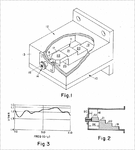Darktrax
Full Member level 5
Cable-fed probes inserted into a wavguide space are familiar to many. They generally insert about half way into the shorter space, and can be variously given cylinder or conical end shapes. Even the centre conductor of a coax cable inserted like this can give 10dB RLR.
Things get more awkward when trying to launch into the gap of a coaxial waveguide (these are often parts of multi-band feed-horns), so one has to use a pair of opposite probes fed in 180° phase, but the probes look the same.
I have tried so many now. There are times when one can get very good return loss, meaning 18dB or 20dB, or even up to 30dB, but only over very narrow bandwidths such as 1% or 2%. For "bandwidth", I mean anything better than (say) 15dB RLR. Even 12dB would be OK provided it was at least that at the band edges.
Are there any ways of doing this so as to get a sightly wider bandwidth - say maybe 6%?
Things get more awkward when trying to launch into the gap of a coaxial waveguide (these are often parts of multi-band feed-horns), so one has to use a pair of opposite probes fed in 180° phase, but the probes look the same.
I have tried so many now. There are times when one can get very good return loss, meaning 18dB or 20dB, or even up to 30dB, but only over very narrow bandwidths such as 1% or 2%. For "bandwidth", I mean anything better than (say) 15dB RLR. Even 12dB would be OK provided it was at least that at the band edges.
Are there any ways of doing this so as to get a sightly wider bandwidth - say maybe 6%?


